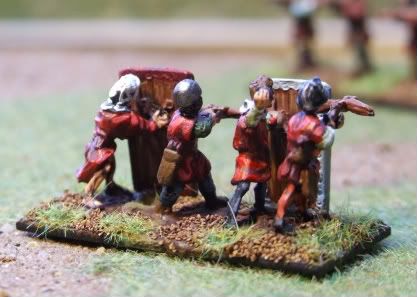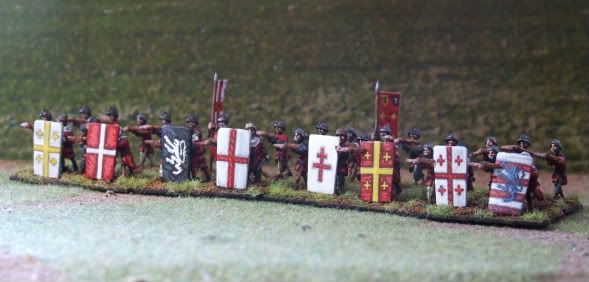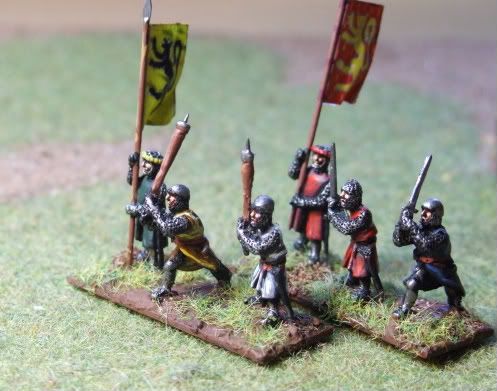Common to a number of Low Countries cities were the guilds of crossbowmen - the Guild of Saint George. They were separate from the trade guilds and are shown in the Leugemeete fresco. There is still a Guild of St George in Ghent which has a nice bit of background.
As mentioned in this link as well as various other places such as Verbruggen, de Vigne and de Liebaart, the crossbowmen were accompanied by 'boys' who carried the pavises at a ratio of two crossbowmen to one pavise. The current draft of the DBMM Book 4 list covering the Low Countries actually suggests basing them in this way after a couple of us mentioned it on the DBMMlist. I suspect that this ratio may have been common in Europe at the time in the period following the adoption of the pavise. David Nicolle's essay on the Genoese at Crecy suggests that the pavises left behind would have been carried by pavise bearers rather than on the back of the crossbowmen as often portrayed following a late 14th century picture. I don't know of any evidence that the Low Countries bearers had any form of spear - certainly at the various battles where the Fleemish crossbowmen are mentioned they withdraw rather than facing hand to hand combat, suggesting a lack of defensive weaponry.
I did try out two crossbowmen and one pavise per base but the effect was a bit sparser than I liked. It would really look best, I think, with a deeper base and one firing and one loading crossbowman per pavise. An Impetus or similar sized base would be a good place to do this, or a double depth DBMM base. After a bit of experimentation I decided to have a rank of bases with pavises and another without, giving a ratio of three crossbows per pavise.
 I spent quite a while looking for figures suitable for the pavise bearers. I actually converted a couple of Khurasan's Swiss halberdiers and would have used these but when I ordered some Welsh spearmen (bearer on the right if this picture) from Donnington I thought the pose and clothing would fit quite nicely.
I spent quite a while looking for figures suitable for the pavise bearers. I actually converted a couple of Khurasan's Swiss halberdiers and would have used these but when I ordered some Welsh spearmen (bearer on the right if this picture) from Donnington I thought the pose and clothing would fit quite nicely. I hoped to have finished them for Britcon but ran out of time. This was quite good though, since I bought some Donnington peasants and some of those also made good bearers.
 The figures wearing a hood actually come wielding a polearm in two hands in a sort of baseball pose. I cut off one arm and built another using green stuff in a pose as if the bearer is holding the pavise to his left.
The figures wearing a hood actually come wielding a polearm in two hands in a sort of baseball pose. I cut off one arm and built another using green stuff in a pose as if the bearer is holding the pavise to his left.The crossbowmen are mostly Donnington with some Touller figures, including the flag bearers. another factor which influenced my choice of basing was that I had exactly the right number of crossbowmen unpainted to do it this way, as long as I used the standard bearers.
The pavises show a mixture of arms, including those of Bruges, Ypres and Ghent. The others are those of Guilds of St.George from various cities as well as those of Guilds of St. Sebastian. This was thoeretically a guild of archers although the fresco showed them with the same mix of weapons as other guildsmen. However I used a bit of licence and included some of their shields as I had the details and liked them.
To finish off my pictures of Low Countries figures, here are some knights. First of all mounted:
The general is marked with a flag and represent Jan de Renesse, a nobleman from Holland who led the forces at Kortrijk - possibly he was experienced. For the other knights I used a variety of arms from the Gelre armorial and Rietstaap as well as a book of seals of 13th century Low Countries knights. I wasn't too careful about whether they had fought for or against the French though - time was pressing and the details were sketchy; sometimes I had names but no details of arms. The arms of the burghers or patrician class were even harder to come by for the 14th century. A few are mentioned such as de Conninck's and, for a later period, van Artevelde's but I couldn't be sure of many others. The regulations have survived which show the expectations of these 'nouveaux riches' as far as equipment goes - the two richest classes were to have armoured horses as well as the rest of the men-at-arms' panoply.
Some of the Donnington knights come with a bird crest - I adapted some of these by cutting or adding Green Stuff so a few have the crest shown in the Gelre Armorial. Wearing crests in battle was becoming rarer as the 14th century progressed but I kept a few as traditionalists or show-offs.
The figures come with smaller shields than this but I got some of the slightly larger ones - partly as it made painting easier.
I have already posted some pictures of Old Glory dismounted knights but I also have some more specifically Low Countires ones. They are figures from Mirliton and IMO some of their best. They are actually designed for a period earlier than the mounted men-at-arms which I used but they match the figures on the Kortrijk chest pretty nicely apart from the ailettes. To get the real Low Countries look, I have converted some to carry gepinde stafs (or whatever the plural is!) You can see the unconverted ones alongside the converts. The staves were made from a dressmakers pin with a covering of greeen stuff or Milliput. Once I knew what I was doing they could be made pretty quickly. Note that I also put a Milliput cerveilliere on one of the knights as shown on the Chest. Overall, I think the central figure gives a nice effect of the picture I have linked to before





5 comments:
Most excellent work, very inspiring! The freehand on the pavise and caparisons is top-notch.
Very nice. Are you planning to cover all major European powers ca 1300?
Oh, and I would very much like to known the CoA of van Artevelde. I haven't been able to find anything. Any source you would recommend for Dutch heraldry?
Well, the French are well underway. I may do some Germans although perhaps just enough to go alongside Teutonic Knights as I have the figures for these already.
There is a book called "James and Philip van Artevelde" which give their arms as sable three chaplets argent.
At least some of the Gelre armorial shields are Dutch I think. Others are German as well as various French and even some Polish and Hungarian I think.
Sorry for dredging this up so long after, but these are really nicely done. I'm doing a French 100 Years' War FoG army, and your work is inspiring. Could the you tell me the manufacturer of the pavises? Thanks!
Hi Dan,
The pavises are from Mirliton's pavisier pack in the Communal range. It is the only one I know of that looks as if it is to be carried rather than propped up or slung on a back.
Post a Comment